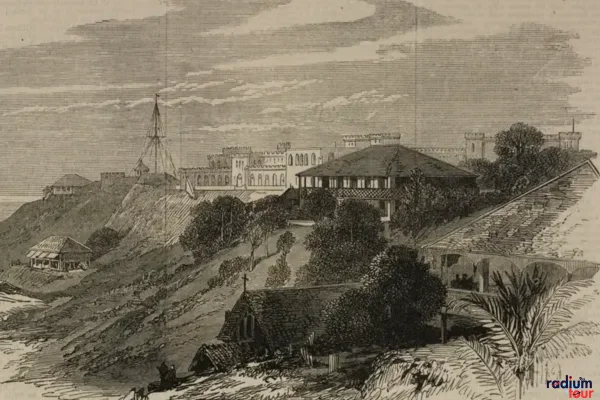Ross Island Penal Colony
Penal Colony: Ross Island
Ross Island, established as a penal colony in 1858, bore witness to the harshness of British rule. The incarcerated faced unsanctioned medical experiments and systematic brutality. Indian prisoners were compelled to construct lavish residences and infrastructure for British officials. From 1857 to 1941, it served as the administrative epicenter for the entire Andaman and Nicobar Islands.
To provide context, a medical assessment in 1862 revealed that a mere 45 out of 10,000 prisoners were deemed medically fit. The remnants of this penal settlement stand as a stark testament to the cruelties inflicted during the era of British colonialism in India. The island’s history is a somber reflection of the suffering endured by countless individuals, a poignant reminder of the past that shaped this region.

History of Penal Colony Ross Island
Established in 1858, Ross Island served as a brutal penal colony, initially housing 200 prisoners under Dr. James Pattison Walker’s control. Conditions were dire, with prisoners tasked to clear the dense forest, construct shelters, and roads while enduring sickness and poor amenities. Over 8,000 prisoners were sent, and 3,500 perished due to harsh conditions.
Improvements came when Colonel RC Tytler and his wife Harriet took charge, though still grim, with a death rate of 700 annually. In the 1870s, diseases and indigenous tribe attacks persisted. Pharmaceutical tests led to severe side effects, prompting cruel punishments.
By 1914, concerns of a potential uprising led to hesitancy in releasing the 15,000 political prisoners during World War I. The colony was disbanded on 7th October 1945. Ross Island, once a site of suffering, is now a haunting tourist attraction.
Things to do in Ross Island Penal Colony:
- Engage in the Enlightening Light and Sound Show starting at 5:15 pm.
- Discover the Fascinating Ruins of the British Colony Nearby.
- Observe the Abundant Wildlife, including Deer and Peacocks.
- Delve into the Island’s Dark Past through Guided Tours.
- Immerse Yourself in the Tranquility of the Island’s Beaches.
- Capture Breathtaking Views from Strategic Vantage Points.
- Engage in Nature Photography amid the Island’s Scenic Beauty.
- Reflect at the Island’s Religiously Significant Spots.
- Experience Snorkeling or Scuba Diving in the Clear Waters.
- Enjoy Picnicking amidst the Island’s Serene Ambiance.

Visitor Information:
- Renowned for: Colonial Heritage, Historical Ruins, Significance in Freedom Struggle.
- Admission: No entry fee required.
- Opening Hours: Open daily until sunset.
- Recommended Duration: Approximately 2 hours.
Frequently Asked Questions
The Ross Island Penal Colony was disbanded on 7 October 1945, after nearly 90 years of operation.
Yes, there were attempts, but escape was considered nearly impossible. Any escapees who were caught were often killed.
Of the 8,000 prisoners transported to the island, approximately 3,500 died due to various illnesses and harsh living conditions.
The Ross Island Penal Colony was established by the British in 1858 as a place to exile political prisoners and hardline individuals, as well as to serve as a punishment center.
No, there is no entry fee required to visit the Ross Island Penal Colony.

